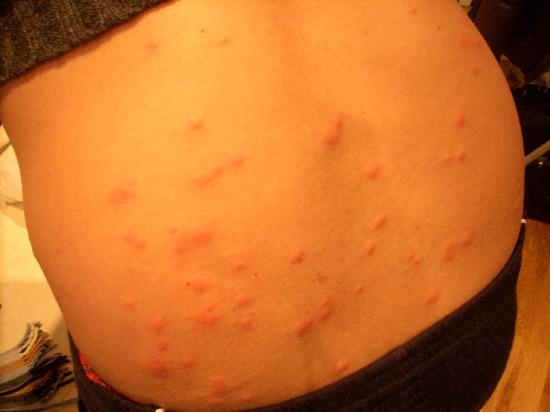Scabies is a skin parasitic disease caused by a mite (Sarcoptes scabiei hominis) living in the epidermis. It comes in two forms: the common form, contagious and relatively benign, and hyperkeratotic form, favored by immune deficiency, extremely contagious and refractory to conventional therapy.
Human transmission takes place mainly through direct skin contact and sometimes by indirect contact (sharing clothing, bedding). The difficulty of treatment is to stop the transmission, which requires dealing simultaneously the patient and his immediate entourage and decontaminated, at the same time, clothing and bedding of all treated.
Clinical signs:
Common scab:
In older children and adults:
– Itching, worse at night, very evocative if it also affects those around
and
– Specific skin lesions:
• Furrows scabious (frequent) lines of 5 to 15 mm, fine, sinuous, corresponding to subcutaneous tunnels dug by the parasite. The grooves are most noticeable at the interdigital spaces of the hands and the inside of the wrists, but may be present on the areola, buttocks, elbows and axillary areas. The back and face are spared. The grooves may be associated with beaded vesicles, corresponding to the entry point of the parasite.
• scabious nodules (less frequent): red-brown nodules, measuring 2 to 20 mm at the genitals in men, persisting despite effective treatment (they do not necessarily indicate an active infection).
and or
– Secondary skin lesions: excoriations (excoriations, crusts) or secondary infection (impetigo).
Specific and secondary lesions may coexist; specific lesions can be completely masked by secondary lesions.
In infants and young children:
– Vesicular rash; palms and soles, back, face, members are often affected. Superinfection or eczematisation is common. Scabies can manifest as simple scabious isolated nodules on the anterior axillary areas.
– Examination of the hands of the mother can come support the assessment.
Hyperkeratotic scabies or “crusted”:
Erythematous plaques, scaly, thick, generalized or localized, like psoriasis, with or without pruritus (50% of cases).Diagnostic delay is the cause of scabies epidemic.
Treatment:
In all cases:
– People in close contact with the patient are treated simultaneously, even in the absence of signs.
– Clothing and bed linen are changed (including relatives) after each treatment. They are either washed ³ 60 ° C and dried in the sun or exposed to the sun 72 hours, or enclosed in a plastic bag for 72 hours.
Common scab:
Local treatment:
Local scabicides are applied all over the body (including the scalp, post-auricular folds, navel, palms and soles), except on mucous membranes and face, and breasts in women who are breastfeeding. It is recommended to emphasize the preferential localization of the parasite. The contact time must not be shortened or extended; the patient must not wash their hands during application (or reapply the product if it is washing hands).
In infants, wrap hands to avoid accidental ingestion. Local scabicides can not be applied to broken or inflamed skin.The treatment of a bacterial infection, if present, should begin 24 to 48 hours before the local scabicidal treatment (see Impetigo, page 105).
Preferably use permethrin 5% (lotion or cream):
Children> 2 months and adults: an application for an 8-hour contact time, and
rinse. Permethrin is easier to use (no dilution), and preferred to benzyl benzoate in children and pregnant / lactating.An application may suffice, a second application 7 days later reduces the risk of treatment failure or default benzyl benzoate 25% lotion:
A second application of benzyl benzoate (p. Ex. To 24 hours apart with a rinsing between the two applications, or two successive applications to 10-minute intervals with drying in between washes and rinse after 24 hours) reduces the risk of treatment failure.
Do not make second application in pregnant women and children <2 years.
Oral treatment:
Treatment with ivermectin PO (200 micrograms / kg single dose) is an alternative: it is more convenient than the local treatment and can be started immediately in the same (eg outbreak or to treat contacts..) If superinfected scabies.
A single dose may be sufficient; a second engagement at 7 day intervals reduces the risk of treatment failure.
Ivermectin is not recommended in children <15 kg and pregnant women (safety not established) “In these patients, treatment should be reserved for severe cases for which there is no alternative.”
In patients with loiasis, the ivermectin a risk of severe neurological complications if microfilariae of Loa loa is very high “In areas where loiasis is endemic, it is recommended to take certain precautions before administering ivermectin: p. ex. determine the microfilariae of Loa loa if possible, or ensure that the patient has no history of loiasis (migration of an adult worm under the conjunctiva of the eye or transient edema “Calabar”), or a history of serious side effects during a previous treatment with ivermectin or, in case of doubt, prefer the local treatment to oral therapy. “
Healing is judged on clinical improvement. Itching may persist for 1-3 weeks after the elimination of the parasite.
The persistence typical scabious furrows after 3 weeks should be suspected treatment failure (insufficient treatment, p. Ex. If the scalp was omitted or lepatient washed his hands during the application period) or a re -infestation early (around untreated or environment). In this case, repeat the treatment of the patient and carers.
The persistence of pruritus may be due to another cause initially masked by scabies.
Gale hyperkeratotic:
The treatment combines oral ivermectin + local scabicidal administered simultaneously at regular intervals, p. ex.every week for 2 or 3 weeks or longer, depending on the severity and clinical course.
The crusts must be softened (salicylic acid ointment) and removed before applying local treatment (otherwise, local treatment can be effective).
Dander promote the spread of pests, the patient should be isolated for treatment, protected personnel (gloves, protective gown, hand washing after contact), the environment (bedding, floors, surfaces) decontaminated.



You must be logged in to post a comment.